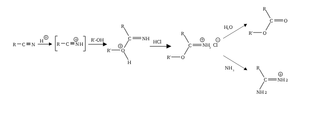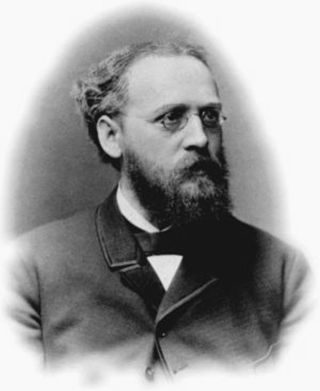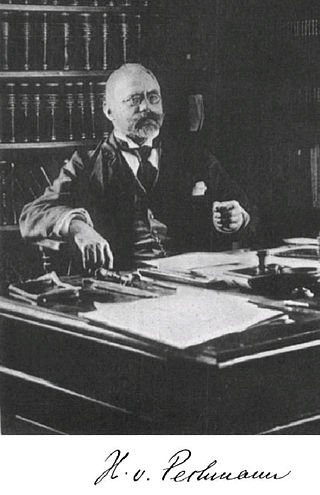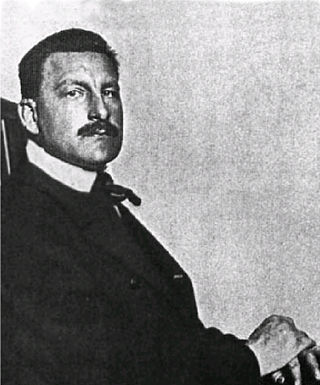Related Research Articles

The Pinner reaction refers to the acid catalysed reaction of a nitrile with an alcohol to form an imino ester salt ; this is sometimes referred to as a Pinner salt. The reaction is named after Adolf Pinner, who first described it in 1877. Pinner salts are themselves reactive and undergo additional nucleophilic additions to give various useful products:

Eduard Buchner was a German chemist and zymologist, awarded the 1907 Nobel Prize in Chemistry for his work on fermentation.

Eugen Baumann was a German chemist. He was one of the first people to create polyvinyl chloride (PVC), and, together with Carl Schotten, he discovered the Schotten-Baumann reaction.

Hermann von Fehling was a German chemist, famous as the developer of Fehling's solution used for estimation of sugar.
Carl Ulrich Franz Mannich was a German chemist. From 1927 to 1943 he was professor for pharmaceutical chemistry at the University of Berlin. His areas of expertise were keto bases, alcohol bases, derivatives of piperidine, papaverine, lactones and also Digitalis-glycosides.

The Eschweiler–Clarke reaction is a chemical reaction whereby a primary amine is methylated using excess formic acid and formaldehyde. Reductive amination reactions such as this one will not produce quaternary ammonium salts, but instead will stop at the tertiary amine stage. It is named for the German chemist Wilhelm Eschweiler (1860–1936) and the British chemist Hans Thacher Clarke (1887–1972).

Viktor Meyer was a German chemist and significant contributor to both organic and inorganic chemistry. He is best known for inventing an apparatus for determining vapour densities, the Viktor Meyer apparatus, and for discovering thiophene, a heterocyclic compound. He is sometimes referred to as Victor Meyer, a name used in some of his publications.
The Leuckart reaction is the chemical reaction that converts aldehydes or ketones to amines. The reaction is an example of reductive amination. The reaction, named after Rudolf Leuckart, uses either ammonium formate or formamide as the nitrogen donor and reducing agent. It requires high temperatures, usually between 120 and 130 °C; for the formamide variant, the temperature can be greater than 165 °C.

The Hofmann–Martius rearrangement in organic chemistry is a rearrangement reaction converting an N-alkylated aniline to the corresponding ortho and / or para aryl-alkylated aniline. The reaction requires heat, and the catalyst is an acid like hydrochloric acid.

Hans Freiherr von Pechmann was a German chemist, renowned for his discovery of diazomethane in 1894. Pechmann condensation and Pechmann pyrazole synthesis. He also first prepared 1,2-diketones, acetonedicarboxylic acid, methylglyoxal and diphenyltriketone; established the symmetrical structure of anthraquinone.

The Wolffenstein–Böters reaction is an organic reaction converting benzene to picric acid by a mixture of aqueous nitric acid and mercury(II) nitrate.
The Schotten–Baumann reaction is a method to synthesize amides from amines and acid chlorides:

Ludwig Gattermann was a German chemist who contributed significantly to both organic and inorganic chemistry.

Ernst Otto Beckmann was a German pharmacist and chemist who is remembered for his invention of the Beckmann differential thermometer and for his discovery of the Beckmann rearrangement.

Jacob Volhard was the German chemist who discovered, together with his student Hugo Erdmann, the Volhard–Erdmann cyclization reaction. He was also responsible for the improvement of the Hell–Volhard–Zelinsky halogenation.

Oskar Piloty was a German chemist.

Hans Heinrich Landolt was a Swiss chemist who discovered iodine clock reaction. He is also one of the founders of Landolt–Börnstein database. He tested law of mass conservation which was given by Lavoisier.

Károly Antal Than de Apát – also called as Carl von Than – was a Hungarian chemist who discovered carbonyl sulfide in 1867.
The Buchner–Curtius–Schlotterbeck reaction is the reaction of aldehydes or ketones with aliphatic diazoalkanes to form homologated ketones. It was first described by Eduard Buchner and Theodor Curtius in 1885 and later by Fritz Schlotterbeck in 1907. Two German chemists also preceded Schlotterbeck in discovery of the reaction, Hans von Pechmann in 1895 and Viktor Meyer in 1905. The reaction has since been extended to the synthesis of β-keto esters from the condensation between aldehydes and diazo esters. The general reaction scheme is as follows:

Géza Gusztáv Zemplén, Ph.D. was a notable Hungarian chemist, organic chemist, professor, and chemistry author. He was a recipient of the Kossuth Prize, a member of the Hungarian Academy of Sciences, and was the brother of Professor Győző Zemplén. His major field of research was structural chemistry and biochemistry including the synthesis of naturally occurring flavonoid-glycosides.
References
- ↑ Life data according to John Andraos Named Organic Reactions E-H, pdf
- ↑ The dissertation was published in Darmstadt: C. F. Winter Buchdr., 1889
- ↑ Chem. Ber., volume 38, 1905, pages 880-892
- ↑ H. T. Clarke, H. B. Gillespie, S. Weisshaus, J. Am. Chem. Soc., Band 55, 1933, 4571–4587
- ↑ Enciclopedia Treccani, Italian (where the Eschweiler-Clarke reaction is referred to as the Eschweiler method)
- ↑ In the entry by Schwarz in the German Apotheker Biography, it is only referred to as the Eschweiler Reaction. It is described there as the formation of tertiary amines (trimethylamine) from formaldehyde and ammonium salts.